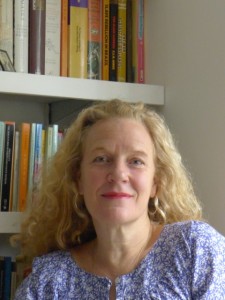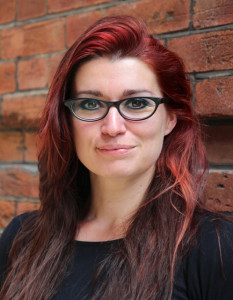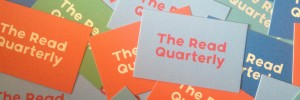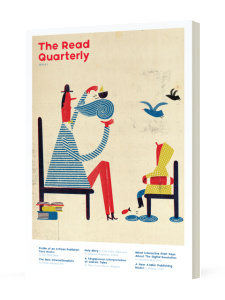Press Release: The Read Quarterly
Neil Gaiman Kickstarter video and Eoin Colfer original fiction help launch The Read Quarterly.
The Read Quarterly (TRQ, www.thereadquarterly.com), the magazine launching in January 2016 to discuss the culture of children’s literature, has today revealed its first issue cover and has announced that the magazine will contain an original four-part Eoin Colfer story, Holy Mary, to be published through the first year. The Read Quarterly will be a forum in which global children’s literature can be discussed and debated. Created by children’s literature enthusiasts, each with a wealth of experience in the publishing industry, Sarah Odedina and Kate Manning, this quarterly magazine will provide an environment in which both writers and readers can share their enthusiasm, introduce new ideas and challenge old ones.
TRQ have also announced details of how to support the first issue of the magazine via Kickstarter and have revealed that Neil Gaiman has been instrumental in setting up that campaign, even recording a video for them to help push the crowd funding.
Sarah Odedina, one of the founders of the magazine, said “We have had such fantastic support since we announced The Read Quarterly. We are excited by the Kickstarter campaign as we feel that its energy suits our magazine so perfectly. Support has already been flooding in from such luminaries as authors including Malorie Blackman and Neil Gaiman, publishers Neal Porter and Louis Baum and bookseller Melissa Cox. We look forward to growing our magazine to reflect the energy and drive that is so characteristic of the children’s literary scene around the world”.
The Read Quarterly. We are excited by the Kickstarter campaign as we feel that its energy suits our magazine so perfectly. Support has already been flooding in from such luminaries as authors including Malorie Blackman and Neil Gaiman, publishers Neal Porter and Louis Baum and bookseller Melissa Cox. We look forward to growing our magazine to reflect the energy and drive that is so characteristic of the children’s literary scene around the world”.
To support the Kickstarter please go to www.kickstarter.com/projects/748565480/the-read-quarterly. Pledges for the project start at £20 and you will receive not only Odedina and Manning’s undying gratitude and the joy of supporting the project from the start, but also exclusive prints, bags and original artwork. From publication, the magazine will be stocked in bookshops and there is also a subscription service from issue two onwards.
 If you are interested in stocking the magazine, please contact Kate Manning at [email protected].
If you are interested in stocking the magazine, please contact Kate Manning at [email protected].
An annual subscription costs £40. For more details please contact [email protected]
For media enquires, please contact:
Kate Manning [email protected]
List of some of the contents of Issue 1
So,we’re about to announce the details of how you can get behind issue 1 and it’s only fair we let you know what’s in the magazine we hope you want to support.
Here’s some of the content list for issue 1 of TRQ. We’re really excited about the wide range of articles and the amazing spread of contributors from around the world, and we hope you like them too. Admittedly, we get a sneak preview of what the articles are about, but hopefully the article titles are tantalising enough.
We have…
‘Hunting for the Birds: A Designer’s Memories of Childhood Reading’ by Stuart Bache, UK
‘Cinderella and a World Audience’ by Nury Vittachi, Hong Kong
‘The Last Taboo: What Interactive Prints Says About the Digital Revolution’ by Elizabeth Bird, USA
‘The Artisan Publisher: Tara Books, Chennai, India’ by Gita Wolf, India
‘A New Arabic Publishing Model’ by Kalimat Publishers, UAE
‘Children and the Magic of Bookshops’ by Jen Campbell, UK
‘From Institution to Market: Publishing for the African Child’ by Ainehi Edoro, Nigeria/USA
‘The Theme of Independence in Children’s Literature in India’ by Jaya Bhattacharji Rose, India
‘The New Internationalists: The Changing Scene of Illustrated Books Published in the UK’ by Martin Salisbury, UK
‘A Singaporean Interpretation of Classic Children’s Stories’ by Myra Garces-Bacsal, Singapore
‘American Nonsense and the Work of Carl Sandburg and Dave and Toph Eggers’ by Michael Heyman, USA
‘The Work of Beatrix Potter and the Loss of Innocence‘ by Eleanor Taylor, UK
‘A Look at Translation’ by Daniel Hahn, UK
And that’s not all, we also have…
Original fiction (well, the the first of four parts) by Eoin Colfer, illustrated by Adrienne Geoghegan, Ireland
Original poetry by Toni Stuart, South Africa
A comic strip explaining what Gary Northfield (UK) really hates drawing
An illustrator profile on Catarina Sobral (Portugal) who has illustrated our amazing first issue cover
AND
A Literary Crossword by Tristan Hanks, UK
9 October 2015




